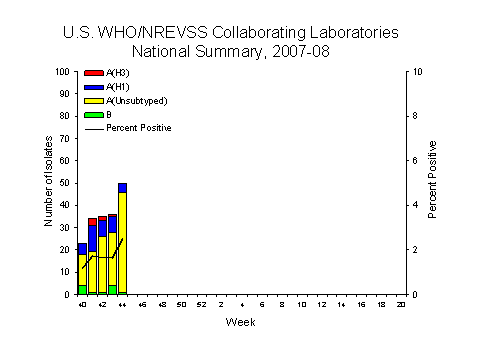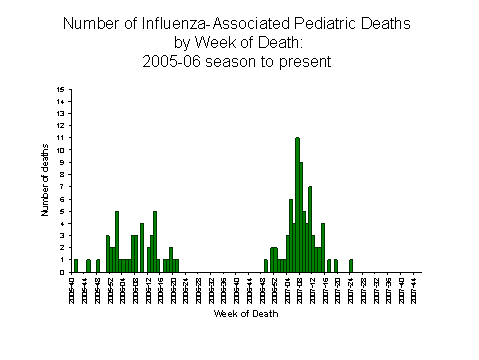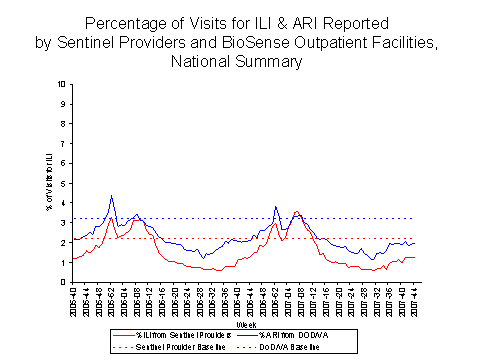Page Options
Media:
Contact Us
- 800–CDC–INFO
- 888–232–6348 (TTY)
- cdcinfo@cdc.gov
Weekly Report: Influenza Summary Update
2007-2008 Influenza Season Week 44, ending November 3, 2007
(All data are preliminary and may change as more reports are received.)Synopsis
During week 44 (October 28-November 3, 2007), a low level of influenza activity was reported in the United States.
- Fifty (2.5%) specimens tested by U.S. World Health Organization (WHO) and National Respiratory and Enteric Virus Surveillance System (NREVSS) collaborating laboratories were positive for influenza.
- The proportion of deaths attributed to pneumonia and influenza was below the epidemic threshold.
- The proportion of outpatient visits for influenza-like illness (ILI) and acute respiratory illness (ARI) was below national baseline levels. The Mountain region reported ILI slightly above its region-specific baseline.
- Two states reported local activity; 17 states, the District of Columbia, and Puerto Rico reported sporadic influenza activity; and 31 states reported no influenza activity.
Region |
Data for current week | Data cumulative for the season | |||||||
|---|---|---|---|---|---|---|---|---|---|
| Sentinel Provider ILI* | DoD and VA ARI* | % pos. for flu† | # jurisdictions reporting regional or widespread activity‡ | A (H1) | A (H3) | A Unsub-typed | B | Pediatric Deaths | |
| Nation | Normal | Normal | 2.5% | 0 of 51 | 35 | 6 | 126 | 11 | 0 |
| New England | Normal | Normal | 0.7% | 0 of 6 | 2 | 0 | 0 | 1 | 0 |
| Mid-Atlantic | Normal | Normal | 0.2% | 0 of 3 | 2 | 0 | 0 | 0 | 0 |
| East North Central | Normal | Normal | 0% | 0 of 5 | 0 | 0 | 0 | 1 | 0 |
| West North Central | Normal | Normal | 0.7% | 0 of 7 | 2 | 0 | 4 | 1 | 0 |
| South Atlantic | Normal | Normal | 3.4% | 0 of 9 | 0 | 2 | 70 | 3 | 0 |
| East South Central | Normal | Normal | 0% | 0 of 4 | 0 | 0 | 0 | 0 | 0 |
| West South Central | Normal | Normal | 2.8% | 0 of 4 | 1 | 3 | 47 | 1 | 0 |
| Mountain | Elevated | Normal | 1.6% | 0 of 8 | 5 | 0 | 1 | 1 | 0 |
| Pacific | Normal | Normal | 2.5% | 0 of 5 | 23 | 1 | 4 | 3 | 0 |
* Elevated means the % of visits for ILI or ARI is at or above the national or region-specific baseline
† National data is for current week; regional data is for the most recent 3 weeks.
‡ Includes all 50 states and the District of Columbia
Laboratory Surveillance
During week 44, WHO and NREVSS laboratories reported 2,015 specimens tested for influenza viruses, 50 (2.5%) of which were positive, including four influenza A (H1) viruses (Mid-Atlantic region), 45 influenza A viruses that were not subtyped (Pacific, South Atlantic, and West South Central regions) and one influenza B viruses (West South Central region). The District of Columbia and 18 states from eight of the nine surveillance regions have reported laboratory confirmed influenza this season.

View WHO-NREVSS Regional Bar Charts | View Chart Data | View Full Screen
Antigenic Characterization:
CDC has antigenically characterized one influenza virus collected by U.S. laboratories since September 30, 2007. The influenza B virus was characterized as B/Florida/04/2006, belonging to the B/Yamagata lineage. Influenza B viruses currently circulating can be divided into two antigenically distinct lineages represented by the B/Yamagata/16/88 and B/Victoria/02/87 viruses. The recommended influenza B component for the 2007-08 influenza vaccine is B/Malaysia/2506/2004-like viruses, belonging to the B/Victoria lineage.
Novel Influenza A Viruses:
One case of novel influenza A infection was reported from Michigan during week 44. The child was infected with swine influenza A (H1N2) virus. This child attended an agricultural event where swine were exhibited, but had no direct contact with pigs. Although human infection with swine influenza is uncommon, sporadic cases occur in many years, usually among persons in direct contact with ill pigs or who have been in places where pigs might have been present (e.g. agricultural fairs, farms, or petting zoos). The sporadic cases identified in recent years have not resulted in sustained human-to-human transmission or community outbreaks. Nonetheless, when sporadic cases are identified, CDC recommends thorough investigations to evaluate the extent of the outbreaks and possible human-to-human transmission as transmission patterns may change with changes in swine influenza viruses.
Pneumonia and Influenza (P&I) Mortality Surveillance
: During week 44, 6.0% of all deaths reported through the 122-Cities Mortality Reporting System were reported as due to P&I. This percentage is below the epidemic threshold of 6.1% for week 44.

View Full Screen
Influenza-Associated Pediatric Mortality
No influenza-associated pediatric deaths were reported during week 44. No deaths have been reported for the 2007-08 season.

View Full Screen
Influenza-Associated Pediatric Hospitalizations
Laboratory-confirmed influenza-associated pediatric hospitalizations are monitored in two population-based surveillance networks: the Emerging Infections Program (EIP) and the New Vaccine Surveillance Network (NVSN). No influenza-associated pediatric hospitalizations have been reported from the EIP. NVSN estimated rates of hospitalization for influenza will be reported every two weeks, beginning November 30, 2007.
Outpatient Illness Surveillance
Nationwide during week 44, 1.2% of patient visits reported through the U.S. Influenza Sentinel Provider Surveillance Network were due to influenza-like illness (ILI) and 2.0% of patient visits to Department of Veteran’s Affairs (VA) and Department of Defense (DoD) outpatient treatment facilities were for acute respiratory illness (ARI). These percentages are less than the national baseline of 2.2% and 3.2%, respectively. On a regional level, the percentage of visits for ILI ranged from 0.8% to 2.8% and the percentage of visits for ARI ranged from 0.9% to 2.4%. The only region that reported ILI above its region-specific baseline was the Mountain region, which reported 1.9% compared to the baseline of 1.6%. All nine regions reported percentages of visits for ARI below their respective region-specific baselines. All five age groups reported percentages of visits for ARI below their respective age-specific baselines.

View Sentinel Providers Regional Charts | View Chart Data |View Full Screen

View Full Screen
Geographic Spread of Influenza as Assessed by State and Territorial Epidemiologists
Influenza activity was reported as local in two states (Florida and Hawaii) and as sporadic in 17 states (Alaska, California, Colorado, Connecticut, Idaho, Indiana, Kentucky, Louisiana, Massachusetts, Minnesota, Mississippi, Nevada, New Jersey, New York, Oklahoma, Texas, and Utah), the District of Columbia, and Puerto Rico. Thirty-one states reported no influenza activity.
--------------------------------------------------------------------------------
A description of surveillance methods is available at: http://www.cdc.gov/flu/weekly/fluactivity.htm
- Page last updated November 9, 2007
- Content Source: Coordinating Center for Infectious Diseases (CCID)
- National Center for Immunization and Respiratory Diseases (NCIRD)



